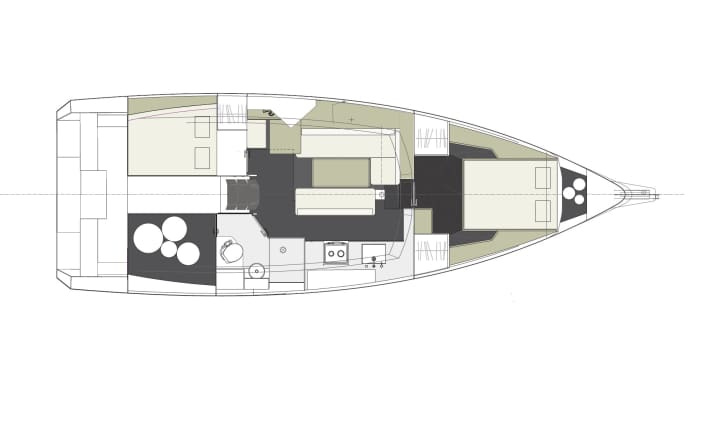
Previously, a skeleton of frames and stringers was created in advance for the construction of the Ovni 400 and the preformed aluminium plates were welded on top. With the new boat, however, the hull is first assembled over a moulded shell framework and the stringers and frames are only then fitted to the hull. For this technique, the plates of the hull are somewhat thicker and heavier, but significantly fewer structural reinforcements are required than with the conventional construction method. In addition, the new hull no longer uses just five aluminium plates, but seven in total. This means that there is one more bend on each side of the fuselage. Alubat has already completely changed the construction process for the construction of the smaller Ovni 370 (test YACHT 6/2022).
With the upgrade from the Ovni 400 to the Ovni 430, the technical data remains largely unchanged, although the keel of the new hull is slightly more pronounced than on the previous model. On the other hand, the previous long keel has been completely removed. The swivelling ballast centreboard is completely retracted into the hull of the new boat. This means that the boat is now more stable overall when falling dry on the wide floor plate and on the two rudder blades. The propeller is now protected by a robust shaft bracket.
Less is more
The swivelling integral centreboard, which was still made of cast iron on the previous model, is now also made of aluminium and is now profiled (Nacra profile) for better sailing characteristics. The fin now weighs just 700 kilograms and can be hoisted more easily and quickly using the electric winch instead of the previous complex hydraulic system. To achieve this, the shipyard has to install additional internal ballast in the form of lead blocks in the ship.
The bulky and heavy targa bracket from the predecessor model Ovni 400 has also been removed from the 430. The mainsheet is now run via two separate tackles on the coachroof, which also proved its worth in the test of the smaller Ovni 370. Although this arrangement requires a little more effort to pull the sheet tight, as a good replacement for a traveller it also has many advantages in terms of trimmability, especially if the boat is to be optionally equipped with the sporty sail plan (fully battened mainsail with square top).

Alubat is also changing the concept for the interior below deck. The Ovni 430 will now also be available as a true deck saloon yacht as a variant to the previous standard layout, i.e. with a raised seating area in the saloon. The aluminium specialists in Les Sables-d'Olonne also offer this variation for the smaller Ovni 370 model in a similar form. For the 430, an interior layout with two spacious double cabins aft and forward is planned. There is also a very spacious wet room with separate shower area. Aft on the starboard side, the space can be used either as a walk-in forecastle, a workshop or, with two additional Pullman berths, as a third double cabin.
The first Ovni 430 is now under construction and will be presented to the public for the first time at the Grand Pavois trade fair in La Rochelle in the autumn. Alubat has also already announced a price: the ship will cost 552,160 euros with the usual extensive and largely blue-water-compatible equipment.
Ovni 430 Technical data
- Construction: Mortain & Mavrikios/CBA
- CE design category: A
- Hull length: 12.28 m
- Overall length with bowsprit: 12.90 m
- Waterline length: 11.54 m
- Width: 4.36 m
- Draught with integral canting keel: 0.85-3.40 m
- Weight: 11.9 tonnes
- Ballast: 2.6 tonnes as internal ballast + 700 kg ballast centreboard
- Mast height above waterline: 18.55 m
- Mainsail: 44.0 m²
- Furling genoa: 31.0 m²
- Motorisation: Volvo D2-50 (36.5 kW) with shaft drive
- Fuel capacity: 580 litres
- Fresh water capacity: 450 litres
Further links on the topic
More current YACHT tests
- Benetau First 36, European Yacht of the Year 2023, Performance Cruiser category
- Linjett 39, European Yacht of the Year 2023, Cruising Yachts category
- Contest 49 CS in a strong wind test
- Elan Impression 43, the YACHT exclusive test
- Comparison test Jeanneau Yacht 60 vs Beneteau Oceanis 60
- Hanse 510, YACHT exclusive test

